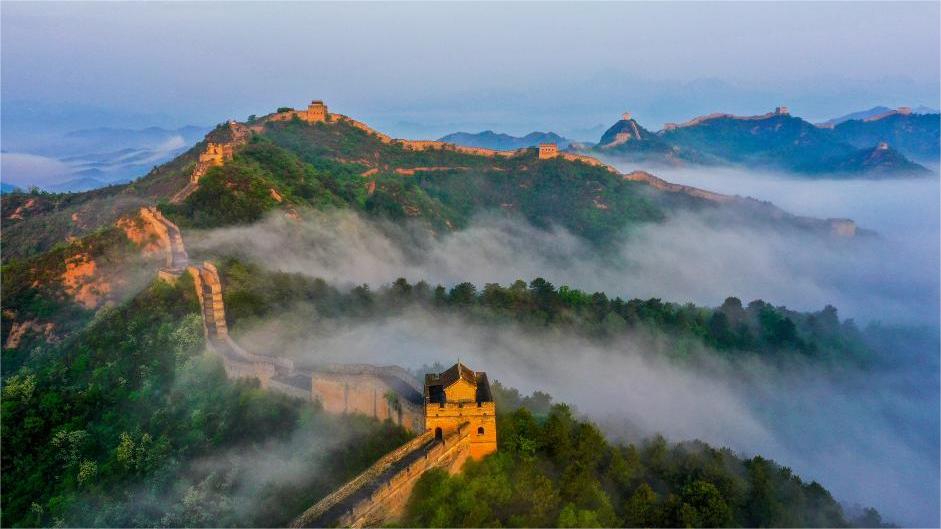Experts' take on Chinese modernization

LI MIN/CHINA DAILY
Editor's note: As the world faces unprecedented challenges, the Chinese path to modernization will be an opportunity for the world. How has the country made achievements in social and economic aspects while promoting people's well-rounded development? Four experts share their views with China Daily.
China seeks better lives for the people
By Zhou Yuehui/Gao Yongzhi
The Communist Party of China has been pursuing modernization since its founding in 1921. It was under the leadership of the Party that reform and opening-up were launched, transforming China into the world's second-largest economy and greatly improving people's living standards. The Party has also led China in eradicating absolute poverty, which is a miraculous achievement for a country of over 1.4 billion people.
Under the leadership of the Party, China has chosen a path of modernization different from that of the West, blazing a trail which other developing countries can learn from and achieve economic development and modernization. All this while, the CPC has remained committed to promoting the high-quality development of Chinese modernization in the new era.
Since its founding in 1921, the Party has drawn lessons from the experiences of China when it was a semi-colonial and semi-feudal society, and early on it realized that real modernization cannot be achieved without gaining national independence.
After the founding of the People's Republic of China in 1949, the Party laid the social foundation for advancing modernization. One of the Party's unshakable commitments is to promote Chinese modernization.
However, China's path to modernization was rocky and tortuous till the launch of reform and opening-up in the late 1970s. Since then China's rapidly growing economy and comprehensive national strength have made great contributions to the development of Chinese modernization.
Following the 18th National Congress of the CPC in 2012, China's pursuit of Chinese modernization has become a strong driving force for global economic growth. For example, China achieved the goal of eliminating extreme poverty at the end of 2020, winning the biggest battle against poverty in human history and making significant contributions to the cause of global poverty reduction.
The rejuvenation of the Chinese nation has now become an irreversible historical trend, and the Chinese people are marching toward the second centenary goal of building China into a great modern socialist country in all respects.
Significantly, Chinese modernization has shown that modernization is not a one-size-fits-all process, nor is modernization equal to Westernization. As a model, Chinese modernization can help the international community, especially developing countries, to realize their modernization.
It is to be noted that high-quality development is essential to building a modern socialist China and realizing Chinese modernization. As such, more efforts should be made to promote high-quality development.
First, the pursuit of Chinese modernization through high-quality development requires upholding the CPC's leadership, because history shows that only under the CPC's leadership can China move ahead on the right path to modernization amid the fast-changing global landscape. To be sure, the Party's leadership is the fundamental guarantee for Chinese modernization to advance. In fact, high-quality development is the route the Chinese economy has taken during the 14th Five-Year Plan (2021-25) period to achieve comprehensive modernization.
Second, the pursuit of Chinese modernization through high-quality development requires the implementation of the new development philosophy. And it is the adherence to the principles of this philosophy that will ultimately determine the success or failure of development.
Chinese modernization is the modernization of a huge population, so it is not possible to rely on traditional forces to drive modernization while facing resource constraints. Instead, it is necessary to improve the quality of development. Chinese modernization is also the modernization of common prosperity, so it is essential to adhere to the shared development philosophy.
Since Chinese modernization is the modernization of harmonious relationship between humankind and nature, it is necessary to adhere to the green development philosophy and prioritize ecological protection while pursuing the Chinese path to modernization. Chinese modernization is also the modernization of peaceful development, so it is necessary to expand opening-up to ensure development benefits for people around the world.
And third, the pursuit of Chinese modernization through high-quality development requires comprehensive deepening of reform. There are still many institutional obstacles restricting high-quality development. Hence, efforts should be made to carry out all-round, multi-faceted reforms in all fields to further stimulate market vitality and the endogenous driving force for high-speed development.
It is also necessary for the country to deepen market-oriented reform, improve the property rights system, and reform the State-owned enterprises as well as the fiscal, taxation and financial systems, in order to optimize the economic structure, improve market competitiveness and promote sustained and healthy economic development.
In the theory and practice of the Party, comprehensively deepening reform also includes promoting the rule of law and modernization of governance, and strengthening integrity so as to promote Chinese modernization.
Zhou Yuehui is a professor of economics at the Party School of the Communist Party of China Central Committee. Gao Yongzhi is a postgraduate student at the Party School of the Communist Party of China Central Committee. The views don't necessarily represent those of China Daily.
Catalyzing sustainable growth in developing world
By Paul Frimpong
Modernization is a process — progressive transition from a "traditional" or "pre-modern" to a "modern" society — which affects all of humanity. There is no single paradigm for modernization, though, with the nature and level of modernization being greatly different from one country or culture to another, reflecting their own historical, cultural and economic conditions and the needs of their people for progress.
The modernization of China — a country with over 1.4 billion people — while progressing smoothly has had far-reaching, positive impacts on the world. China's modernization policy, initiated in the late 1970s, represents a transformative endeavor aimed at turning the country into a global economic and technological powerhouse.
The policy can be seen as a transformative effort aimed at maintaining social stability and achieving economic prosperity on the road to realizing national rejuvenation. The policy encompasses various aspects, including economic development, technological advancement, infrastructure improvement, military modernization and poverty alleviation.
The multifaceted approach to achieving modernization China has taken includes deepening reform and opening-up, improving infrastructure, advancing technologies, developing a knowledge — and innovation-driven workforce, and sharpening diplomacy, which stand as a testament to the country's determination to pursue modernization.
China has made unparalleled progress toward realizing modernization. As China continues to evolve, its modernization policy has been serving as a blueprint for sustainable development and a model for other countries aspiring to achieve high-level development.
China's modernization policy is rooted in the country's historical journey. Despite once leading the world in terms of wealth and technologies, China faced setbacks, especially during the two Opium Wars — (1840-42 and 1856-60) — which hindered its economic progress. However, the founding of the People's Republic of China in 1949 provided a fundamental basis for China to pursue modernization. Since then, China has made remarkable achievements in the field, as evidenced from the huge jump in Sino-African trade — from $12.14 million in 1950 to a staggering $282 billion in 2022.
China's relentless pursuit of modernization, driven by its fast-paced economic growth, technological innovations, spread of education and international collaboration, is aimed at realizing the ultimate goal of building a "great modern socialist country" by the middle of the 21st century, and thus significantly contributing to global progress.
China's unique approach to modernization, rooted in socialism with Chinese characteristics, offers an alternative path to socioeconomic development. This approach prioritizes the well-being of its people and emphasizes the harmonious co-existence between humans and nature. This has led to multiple global initiatives and programs that have helped boost economic growth in African and other developing countries.
China's modernization policy is focused on people-centered development, common prosperity, and the peaceful co-existence of humans and nature. Using this approach, China lifted about 800 million people out of poverty since reform and opening-up and built a moderately prosperous society in an all round way in just more than four decades, and looks forward to achieving socialist modernization by 2035 and becoming a "great modern socialist country" by 2050.
Amid all this, Sino-African ties continue to receive positive feedback, highlighted by the significant increase in two-way trade, which has played a pivotal role in China's modernization policy.
The substantial investments China has made in infrastructure projects across Africa reflect its commitment to foster economic development and innovations beyond its borders. And China's agricultural modernization initiative in Africa shows that it recognizes the continent's agricultural potential. No wonder despite the challenges, China plans to enhance agricultural cooperation with Africa on multiple fronts.
Also, China aims to support the development of Africa's agricultural and industry chains through the Common Africa Agro-Parks Program, by engaging in localized production of agricultural inputs and improving productivity. And the Sino-African collaboration on agricultural technology will intensify through joint research centers, focusing on seed varieties and high-yield production.
More important, thanks to the Belt and Road Initiative, China's investments in African countries have increased, including in sectors such as manufacturing, mining, agriculture, telecommunications and energy. These investments have not only created jobs but also contributed to technology transfer, boosting the industrialization process and skill development, and expanding the production capacity.
In fact, the Belt and Road Initiative's focus on economic development aligns with Africa's aspirations for sustainable growth and poverty reduction. By investing in infrastructure and industries, the Belt and Road Initiative has the potential to boost Africa's economic growth, sharpen the country's international competitiveness, improve connectivity and facilitate trade, which could alleviate poverty and raise the living standards of the people.
In other words, China's modernization campaign has been successful in transforming its economy and infrastructure, and there is little doubt that the Belt and Road Initiative has created opportunities for many developing countries, including African countries, to benefit from China's pursuit of modernization. Despite criticisms, the BRI remains a useful platform for promoting international trade, investment, and fostering economic growth.
The author is the executive director of the Africa-China Center for Policy and Advisory. The views don't necessarily reflect those of China Daily.
Chinese modernization to benefit humanity
By Khalid Taimur Akram
China has displayed remarkable resilience and unity, making unparalleled achievements in areas such as reform, opening-up and socialist modernization, as China-led initiatives prioritize cooperation and form the basis for China's modernization and progress in different fields.
The pursuit of comprehensive development is the primary objective of China's leadership with the aim of building a modern socialist country. Apart from improving work and people's daily lives, China's innovative breakthroughs in science and technology offer developing countries ways to boost their economic growth.
The Chinese path to modernization, characterized by its focus on economic growth and efficient policy implementation, has yielded immensely impressive results, with China's governance system and development model serving as a testament to the remarkable potential the country will have after realizing its development and modernization goals.
The pursuit of high-standard opening-up remains a key facet of China's modernization as it embarks on the path to a brighter future. Events like the Belt and Road Forum for International Cooperation and the China International Import Expo are emblematic of China's deepening alignment of interests with the global community. In fact, China is investing more and more resources in global development and cooperation, while making efforts to ensure global financial and monetary systems fulfill their fundamental role of serving the real economy and promoting modernization.
The Chinese path to modernization is rooted in the principle of common prosperity. This commitment to ensure that every person benefits from the country's development has led to the creation of a more equitable and inclusive society. Common prosperity is a core requirement of socialism and a distinctive feature of China's modernization, providing insights into the historical patterns governing the country's unique modernization journey.
China's rich cultural heritage plays a pivotal role in shaping its society. China's approach to modernization emphasizes the importance of preserving its rich cultural heritage while pursuing economic growth and fostering a prosperous future for the Chinese people. Recognizing the significance of environmental protection and a sustainable economy, the Chinese government has implemented policies aimed at achieving sustainable development, reducing pollution, safeguarding natural resources, and better protecting the environment.
Under the Communist Party of China's leadership, China has not only become the world's second-largest economy, a manufacturing powerhouse and leader in global trade and holder of the highest foreign exchange reserves in just four decades, but also charted its unique course toward modernization. On this remarkable journey, it has also established extensive education, social security and healthcare systems.
The Chinese leadership has fostered national unity and social harmony, and the Chinese approach to modernization places great emphasis on socialism with Chinese characteristics for the country's journey toward modernization. This approach involves developing the economy while upholding socialist values and maintaining social stability and harmony, and its priorities include improving people's livelihoods, providing equal opportunities to the people, and ensuring economic growth benefits all.
The path to Chinese modernization recognizes that spiritual enrichment is essential for the overall well-being of the people, and the ultimate goal of Chinese modernization is the well-rounded development of the people, including their material, cultural, ethical and spiritual enrichment. However, the CPC's dedication extends beyond seeking happiness for the Chinese people and realizing national rejuvenation; it encompasses the pursuit of humanity's progress and global harmony. The China-proposed Belt and Road Initiative and Global Development Initiative, and the Forum on China-Africa Cooperation can be seen as extensions of the concept of common prosperity.
China's contribution to global modernization is exemplified by initiatives such as the Belt and Road Initiative, the Global Development Initiative, the Global Security Initiative and the Global Civilization Initiative, which are global public goods that reduce physical distances and foster shared interests and prosperity.
China's approach to modernization is not limited to its borders; instead it extends beyond its borders, offering hope for a shared and better future for humanity as a whole. China's approach is one of all-inclusive development. In fact, China has established a distinct and effective development model, which other countries can learn from to achieve development, maintain peace and pursue prosperity on its terms. China's approach prioritizes all-inclusive development.
Therefore, the West should refrain from interfering in China's modernization drive and stop disrupting its progress toward modernization. It is imperative that the Western world recognizes and respects China's unique path to modernization, refrains from taking actions that could hinder its progress or engaging in anti-China propaganda.
In short, China's journey toward modernization underscores the possibilities that lie ahead for countries willing to chart their own course of development and modernization. As a nation that continues to evolve and thrive, China exhibits the potential for a brighter future, both at home and on the global stage, through its unique approach to modernization.
The author is executive director of the Pakistan Research Center for a Community with Shared Future, Islamabad. The views don't necessarily reflect those of China Daily.
Photos
Related Stories
- Chinese modernization inspiring for world, say participants at World Media Summit
- To understand China, key lies in understanding Chinese modernization
- Commentary: Humanomics offers enlightening ways to resilient growth
- Understanding China Conference held in Guangzhou
- From farmland to high-tech zone, Shanghai's Pudong mirrors China's modernization drive
- Reform propels China's rural areas on path to modernization
Copyright © 2024 People's Daily Online. All Rights Reserved.









